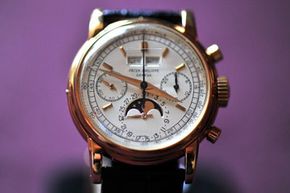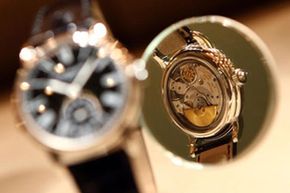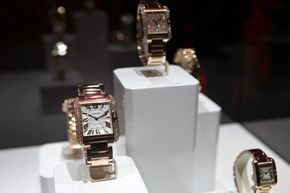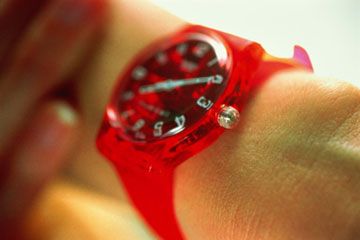Many sources credit Swiss watchmakers Pierre Jaquet-Droz and Jean-Frédéric Leschot as the first to make a watch to be worn on the wrist, in 1790 [sources: Tourneau, Jaquet-Droz]. They attached a watch to a woman's bracelet, but the idea didn't catch on.
Another fine Swiss watchmaker, Patek Philippe, is more widely credited with making the first wristwatch, in 1868. These watches were also for women, and were considered as much jewelry for wealthy women as accurate timepieces. They were often called wristlets. Later, in the late 19th and early 20th centuries, less expensive wristwatches gained popularity among women due to mass production.
On the other hand, men preferred pocket watches, considering wristwatches ladylike because they would get in the way of a man's work.
More technological innovation -- and then war -- changed all that.
During the late 19th century, soldiers and sailors had problems carrying and using pocket watches at sea and on the battlefield. Some began improvising leather straps that would hold pocket watches on their wrists. Such watches were important in the German Imperial Navy in the 1880s and in the British victory in the Anglo-Boer War in South Africa around the turn of the 20th century, where British soldiers used wristwatches to coordinate troops and plan precisely timed attacks on Boer forces [source: Rolex].
A pilot's lament led to a huge jump in the evolution of the wristwatch at the turn of the 20th century. Albert Santos Dumont was a Brazilian aviation pioneer who reportedly complained to his friend, watchmaker Louis Cartier, that it was difficult to use his pocket watch while flying, and begged for an alternative. In 1904, Cartier created a man's pocket watch with a leather strap and buckle to solve his friend's problem [source: Santos Dumont Aircraft Management].
A decade later, the pressures of modern warfare made more military leaders recognize the value of wristwatches, as soldiers in World War I wore wristwatches so they could keep track of time while using their hands. It was official: Wristwatches were now manly. Pocket watches became much less common by the mid-20th century.
Early handcrafted watches could be made for the left or right wrist. But as watches gained popularity, they were usually made for the left wrist because most people are right-handed, and they found it easier to wind the watch with their right hand. What's more, their right hand could keep working when they checked the time. By the time electronic watches came on the market, the style of wearing watches on the left wrist was set, although some lefties wear watches on their right wrists.
In the late 20th century, any well-dressed person usually wore a wristwatch. Read on to find out why.




